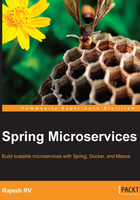
Developing a RESTful service – the legacy approach
This example will review the traditional RESTful service development before jumping deep into Spring Boot.
STS will be used to develop this REST/JSON service.
The following are the steps to develop the first RESTful service:
- Start STS and set a workspace of choice for this project.
- Navigate to File | New | Project.
- Select Spring Legacy Project as shown in the following screenshot and click on Next:

- Select Spring MVC Project as shown in the following diagram and click on Next:

- Select a top-level package name of choice. This example uses
org.rvslab.chapter2.legacyrestas the top-level package. - Then, click on Finish.
- This will create a project in the STS workspace with the name
legacyrest.Before proceeding further,
pom.xmlneeds editing. - Change the Spring version to
4.2.6.RELEASE, as follows:<org.springframework-version>4.2.6.RELEASE</org.springframework-version>
- Add Jackson dependencies in the
pom.xmlfile for JSON-to-POJO and POJO-to-JSON conversions. Note that the2.*.*version is used to ensure compatibility with Spring 4.<dependency> <groupId>com.fasterxml.jackson.core</groupId> <artifactId>jackson-databind</artifactId> <version>2.6.4</version> </dependency> - Some Java code needs to be added. In Java Resources, under legacyrest, expand the package and open the default HomeController.java file:

- The default implementation is targeted more towards the MVC project. Rewriting
HomeController.javato return a JSON value in response to the REST call will do the trick. The resultingHomeController.javafile will look similar to the following:@RestController public class HomeController { @RequestMapping("/") public Greet sayHello(){ return new Greet("Hello World!"); } } class Greet { private String message; public Greet(String message) { this.message = message; } //add getter and setter }Examining the code, there are now two classes:
Greet: This is a simple Java class with getters and setters to represent a data object. There is only one attribute in theGreetclass, which ismessage.HomeController.java: This is nothing but a Spring controller REST endpoint to handle HTTP requests.
Note that the annotation used in
HomeControlleris@RestController, which automatically injects@Controllerand@ResponseBodyand has the same effect as the following code:@Controller @ResponseBody public class HomeController { } - The project can now be run by right-clicking on legacyrest, navigating to Run As | Run On Server, and then selecting the default server (Pivotal tc Server Developer Edition v3.1) that comes along with STS.
This should automatically start the server and deploy the web application on the TC server.
If the server started properly, the following message will appear in the console:
INFO : org.springframework.web.servlet.DispatcherServlet - FrameworkServlet 'appServlet': initialization completed in 906 ms May 08, 2016 8:22:48 PM org.apache.catalina.startup.Catalina start INFO: Server startup in 2289 ms
- If everything is fine, STS will open a browser window to
http://localhost:8080/legacyrest/and display the JSON object as shown in the browser. Right-click on and navigate to legacyrest | Properties | Web Project Settings and review Context Root to identify the context root of the web application:
The alternate build option is to use Maven. Right-click on the project and navigate to Run As | Maven install. This will generate chapter2-1.0.0-BUILD-SNAPSHOT.war under the target folder. This war is deployable in any servlet container such as Tomcat, JBoss, and so on.